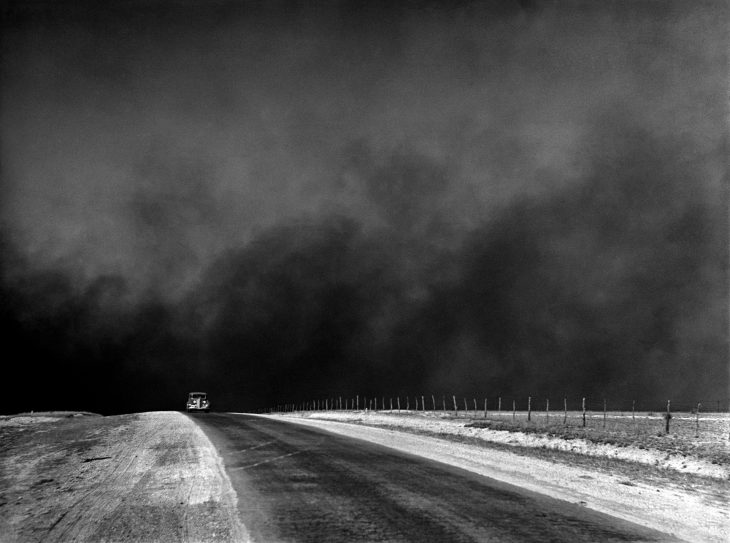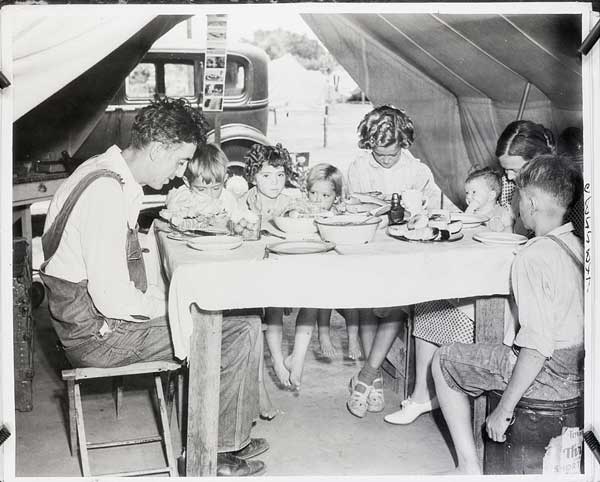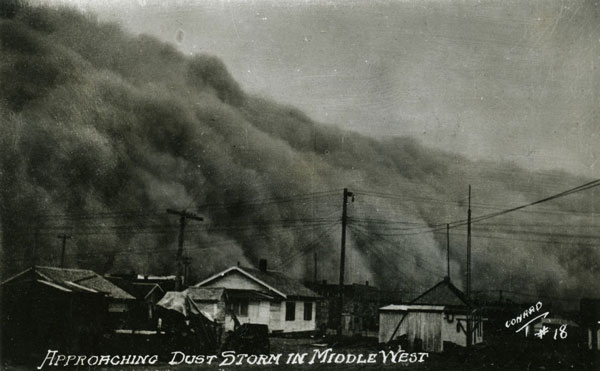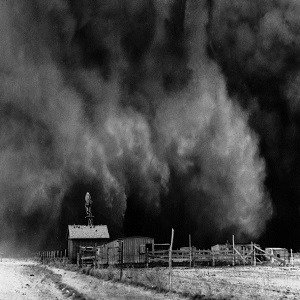
- Other Names: Dirty Thirties
- Definition: Period of severe dust storms
- Cause: Over-plowed and over-grazed land
- Time Period: 1930s
- Location: USA and Canada
- States: Oklahoma, Texas, New Mexico and others
- Affected Area: 100,000,000 acres
- Books: John Steinbeck’s Of Mice and Men (1937) and The Grapes of Wrath (1939)
- Music: Woody Guthrie’s So Long, It’s Been Good to Know Ya
- Documentaries: The Dust Bowl (2012), The Plow That Broke the Plains (1936)
- History: The First Storms of the Dust Bowl Started Hitting the US in 1931
- History: The Dust Bowl Finally Ended in the Fall of 1939
- Causes: The Dust Bowl Was Both a Natural and a Man-Made Disaster
- History: The Worst Storm of the Dust Bowl Took Place in April 1935
- Effects: The Storms Carried Enough Dust to Suffocate Cattle and Engulf Entire Towns
- Effects: The Storms Created Enough Static Electricity to Knock Down Grown Men
- Effects: The Dust Bowl Was Lethal for Many People, Mostly Infants and the Elderly
- Effects: In Addition to Dust and Draught, Jackrabbits and Grasshoppers also Hit the Plains
- Geography: 200,000 People Moved to California Because of the Dust Bowl
- Politics: Franklin Roosevelt’s New Deal Was a Program to Help Heal the Land
- The Dirty Thirties’ Storms Significantly Reduced Birth Rates in the US
- Some of the Dust Bowl’s Storms Were Severe Enough to Reach the East Coast
- Migrants That Fled from the Dust Bowl Were Given the Name Okies
- Although Many People Moved, the Majority Stayed and Stuck It Out
- The Dust Bowl Area Residents Tried Almost Anything to Stop the Storms
- The Name “Dust Bowl” Was Invented by a Newspaper Reporter
- The Famous Route 66 Played an Important Role during the Dust Bowl
- The Dust Bowl Left a Significant Mark on the Economy
- Moving Images of the Dust Bowl Era Are Captured in Dorothea Lange’s Photographs
- The Dirty Thirties Were Not the Only Dust Storm Period in History
The First Storms of the Dust Bowl Started Hitting the US in 1931
Dust Bowl facts reveal that the Dust Bowl started in 1931 when a severe drought hit the Midwestern and Southern Plains, causing the crops to die and the over-plowed and over-grazed soil to be blown around by strong winds, creating dust storms that covered the land. In 1932, there were 14 major dust storms reported and in 1933, there were 38. In 1934, the worst drought in US history spread through 75% of the country, also causing the dust storms to spread from the initial area to numerous other states.
The Dust Bowl Finally Ended in the Fall of 1939
Dust Bowl facts reveal that the time after the dust storms spread was a very difficult time for the USA. The Dust Bowl destroyed many lives and so did the Great Depression that hit the country at the same time. President Roosevelt initiated the Shelterbelt Project in March 1937 to protect the land from further erosion by planting trees across the Great Plains, everywhere from northern Texas to Canada. Although the drought continued throughout the following year, Roosevelt’s program and other efforts managed to reduce the blown dust by over 60%. In the fall of 1939, the first rains finally came and ended the drought that started wreaking havoc eight years earlier…
The Dust Bowl Was Both a Natural and a Man-Made Disaster

According to Dust Bowl facts, this phenomenon was both a natural and a man-caused disaster. Farmers used the then new gasoline tractors as wheat sales boomed, over-plowing and over-grazing the land. In addition to that, farmers didn’t plant any drought-resistant crops that would hold the soil in place when strong winds started blowing. These man-made conditions were worsened by the great drought that affected several US states in the beginning of the 1930s and turned soil into dust. Strong winds carried the dust across the country, thus starting the Dust Bowl period, which ravaged the land for nearly a decade.
The Worst Storm of the Dust Bowl Took Place in April 1935
Dust Bowl facts reveal that the worst of the many dust storms in the US during the 1930s occurred on April 14, 1935, a day which is now known as Black Sunday. Why black? Because it blackened several cities in the area from the Atlantic coast to 200 miles further inland. Massive amounts of dust were accompanied by millions of insects and thousands of animals fleeing the area, causing a spectacular sight that convinced many that the Armageddon was coming. There is even a story of one woman wanting to spare her child the horror of experiencing the Armageddon, so she killed the child herself…
The Storms Carried Enough Dust to Suffocate Cattle and Engulf Entire Towns
Dust Bowl facts reveal a shocking truth that the average dust storm from the 1930s carried more dirt than was dug out to create the entire Panama Canal. Thus it is not surprising that the storms engulfed homes, and sometimes entire towns and cities, killed livestock and severely endangered the lives of people too. It is estimated that 7,000 people lost their lives in the great dust storms, along with tens of thousands of animals. In addition to this, travel was nearly impossible, so people were stuck in whatever place they were when the storm hit, which greatly interfered with the everyday lives of everyone, since it made the work of hospitals, schools and many other institutions very difficult.
The Storms Created Enough Static Electricity to Knock Down Grown Men
A single dust storm was able to generate enough static electricity to short-circuit radios and other electronic devices, damage car engines, and even cause barbed wire fences to be engulfed in strange-looking blue flames. All this static electricity built up between the ground and the dust that was flying around, and was practically impossible to avoid. People who were driving installed chains to the back of their cars so that they dragged along the way, grounding the car, and people avoided contact with each other since the static electricity was so strong it could throw grown men off their feet. And how strong exactly was the built-up static electricity? Well, the infamous Black Sunday storm produced enough static electricity to power New York City…
The Dust Bowl Was Lethal for Many People, Mostly Infants and the Elderly
People who inhaled dust from the storms suffered shortness of breath, asthma, bronchitis, influenza, coughing spasms and even “dust pneumonia”. Dust pneumonia, often called also the “brown plague”, killed hundreds, perhaps even thousands, of people, and was particularly dangerous for infants, children and the elderly, whose immune systems couldn’t battle the disease as efficiently.
But the “brown plague” was not the only killer brought by the Dust Bowl; even more people died from malnutrition caused by the extreme conditions and from suffocation due to the dust particles in the most intense storms.
In Addition to Dust and Draught, Jackrabbits and Grasshoppers also Hit the Plains
As if the severe dust-and-dirt storms and drought didn’t hurt the plains enough, Dust Bowl facts also reveal that numerous jackrabbits and grasshoppers plagued the plains during that time. Their invasion was caused by a disruption in the ecosystem – jackrabbits and grasshoppers were forced to invade the plains in search of any meager crops that still grew. The apocalyptical dust storms were made even more gruesome by the unleashed plague of tens of thousands of jackrabbits and grasshoppers, and many people really started to believe that the Biblical Apocalypse was coming.
To combat the animal invaders, people living in the Dust Bowl area had to take extreme measures – they organized special “rabbit drives” during which they drove the jackrabbits into special pens and beat them to death with clubs, baseball bats and any other tools they could find. The National Guard was also called to help with the grasshoppers – they crushed them with tractors and burnt infected fields.
200,000 People Moved to California Because of the Dust Bowl

During 1935, the dust storms became so dangerous that many families in the Dust Bowl area were forced to leave their homes and travel far away to seek refuge. They fled their homes not only due to the violence of the storms, but also because the conditions left them unable to work and survive, so they were forced to find work elsewhere. Approximately 200,000 farmers left the Dust Bowl area and relocated to California. But, unfortunately, most of them were not able to find work, and even those who did were paid very little, so most of them were forced to live in makeshift settlements that were known as “Hoovervilles”. But these 200,000 migrants represented only a small proportion of all the people who were forced to find a new home. The Dust Bowl period saw the largest migration numbers in American history, with approximately 3.5 million people in total moving out of the affected states (Oklahoma, Arkansas, Missouri, Iowa, Nebraska, Kansas, Texas, Colorado and New Mexico).
Franklin Roosevelt’s New Deal Was a Program to Help Heal the Land
Violent dust storms were not the only problem that plagued the USA in the 1930s; they were only a part of a larger economic crisis, known as the Great Depression, which forced millions to live on the brink of survival. President Roosevelt was thus forced to take some quick and efficient steps in order to improve the grave situation that threatened the US. His famous New Deal programs lasted from 1933 to 1938 and also included various measures aimed at improving the state of the agricultural industry, among which the five most important were: the Agricultural Adjustment Act, the Civilian Conservation Corps, the Farm Security Administration, the Soil Conservation Services and the Rural Electrification Act.
The Dirty Thirties’ Storms Significantly Reduced Birth Rates in the US
The Dust Bowl did not only reduce the population by leading to an increase in the death rate, but also by leading to a fall in the birth rate. Dust Bowl facts show that the birth rate in the 1930s dropped below 20 children per 1,000 women. As farms were abandoned, so were people’s plans to get married or have children. The drought and consequent famine caused people to worry about their own short-term survival, which left little time to think about having a family…
Some of the Dust Bowl’s Storms Were Severe Enough to Reach the East Coast

Although the “black blizzards”, as the Dust Bowl storms were also known as, originated in the Plains area and mostly menaced only the states in the area, some dust storms were so big and so powerful that they traveled hundreds of miles. One such violent storm that occurred in spring of 1934 was 2 miles high and managed to travel 2,000 miles to the East Coast, reaching New York, Atlanta, and as far north as Chicago. The Statue of Liberty and the US Capitol, inside which people were coincidently debating a potential soil conservation bill, were covered in dust, but only for a few hours, so the residents of these areas felt the Dust Bowl as a mere short-term inconvenience in contrast to the people who actually lived in the Plains area…
Migrants That Fled from the Dust Bowl Were Given the Name Okies
Hundreds of thousands of farmers that fled their homes in order to survive the Dust Bowl were often called “Okies” by others. “Okies” is a term deriving from the state of Oklahoma, but it was not only used for Oklahoma farmers (which only represented around 20% of all migrants) – it was used for all migrant farmers, regardless of their home state. In many places, these migrants were greeted with hostility, which was, for example, clearly shown with signs in front of diners that read “Okies and dogs not allowed inside.”
Although Many People Moved, the Majority Stayed and Stuck It Out
Although around 3 million people moved from the Dust Bowl area to the nearby states of Arizona, Washington, Oregon and California in the US, and to Ontario in Canada, Dust Bowl facts reveal that about 75% of people in the area decided to stay and simply “stick it out”. Not many people are aware of that, since most movies that depict the era, or books that deal with it, such as John Steinbeck’s famous books Of Mice and Men and The Grapes of Wrath, focus on those who fled the area in order to find better lives instead of those who chose to stay.
The Dust Bowl Area Residents Tried Almost Anything to Stop the Storms
Dust Bowl facts reveal that some of their solutions were truly unconventional. As the drought was a major factor in dust storms, the residents of the area desperately tried to cause rain – some followed folklore and killed snakes to hang them belly-up on their fences, some paid “professional rainmakers” ridiculously high amounts of money to shoot special nitroglycerine-fueled rockets into the sky in the hope of inducing rain, and various companies offered their “brilliant” solutions for stopping the storms and the drought to the government. The latter included ideas such as covering the farms of the area in waterproof paper and paving the entire Plains…
The Name “Dust Bowl” Was Invented by a Newspaper Reporter
Dust Bowl facts reveal that a reporter from the Associated Press named Robert E. Geiger was present in Oklahoma on April 14, 1935 during the infamous “Black Sunday” dust storm.
He wrote an article to be published the next day and, while he was re-writing it, his editor, Edward Stanley, coined the term “Dust Bowl”, using it in the title: “Three little words achingly familiar on a Western farmer’s tongue, rule life in the dust bowl of the continent—if it rains.”
The term quickly spread and was later used by all media, but – in contrary to now – only referring to the geographical area where dust storms roamed. Nowadays, it is also used to describe the period in the 1930s.
The Famous Route 66 Played an Important Role during the Dust Bowl
U.S Route 66 (also known as US 66, Route 66, Will Rogers Highway, the Mother Road or the Main Street of America) played an important role during the Dust Bowl as it served as one of the major paths of people who migrated west. People who lived or offered services along it greatly prospered during the 1930s, since they had hundreds of thousands of potential customers traveling through.
Route 66 was established only a few years prior to the Dust Bowl and the great migrations the Dust Bowl caused, in November 1926. It originally ran from Chicago, Illinois, through areas that were most affected by the dust storms such as Oklahoma, Texas and New Mexico, and ended in Santa Monica, California. The 2,448 miles of Route 66 gave eternal hope to the migrating farmers of finally finding a better life for themselves and their families…
The Dust Bowl Left a Significant Mark on the Economy
At almost a decade long, the Dust Bowl catastrophe couldn’t simply pass without leaving the economy of the broader Dust Bowl area in ruins. More than 75% of the topsoil was blown away, causing a great decrease in agricultural land values. In areas where the erosion was the highest, less than 25% of agricultural losses could be recovered, and the population greatly decreased and remained low for decades after the Dust Bowl. Farmers could have sped up the process of recovery by shifting from their usual crops to animals and hay, but most of them were not even aware of the benefits of shifting. In addition to this, most were unable to obtain the necessary bank credit to make changes in production.
Moving Images of the Dust Bowl Era Are Captured in Dorothea Lange’s Photographs
The Dust Bowl and the Great Depression era in general were well-documented by various photographers, authors and even musicians who were hired and paid by the federal government to create their own accounts of the great crisis. One of them was Dorothea Lange, a photographer hired by the Farm Security Administration (FSA). She took numerous well-known photographs of Dust Bowl conditions, which were of course black-and-white, just like the actual dust-covered sky of the time. Her photographs focused on the people who suffered the most during the Dust Bowl period: farmers, mothers, children, migrants…
The Dirty Thirties Were Not the Only Dust Storm Period in History
Surprisingly, Dust Bowl facts reveal that the 1930s Dust Bowl was not the only dust storm period in the history of the USA. In 1952, another major drought hit the USA and started a 5-year period known as the “Filthy Fifties”, and the mid-1970s and the late-1990s also had droughts that sometimes caused dust storms. The danger of dust storms still exists today in the Plains area, but now dust storms are much less frequent and are smaller. However, if the Ogallala Aquifer, which lies beneath the Great Plains, ever runs dry (and some people believe it may in a few decades), we will see the desolation major dust storms can cause once again…
Dust Bowl Facts — Facts about the Dust Bowl Summary

“Dust Bowl” is a term that was originally coined by Associated Press journalists to refer to the geographical area of the Great Plains in the USA and Canada which was hit by violent dust storms in the 1930s, but is nowadays used to describe the whole event. The Dust Bowl was both a natural and a man-made disaster – the soil of the area was over-plowed and over-grazed by local farmers and this in combination with a long-lasting drought and strong winds caused powerful dust storms. Dust storms caused farmers to migrate in their hundreds of thousands to nearby states, killed thousands of animals and people, and destroyed a big part of the economy of the area. Similarly to the Great Depression, which coincided with the violent dust storms in the Great Plains in the 1930s, the Dust Bowl was addressed by President Roosevelt’s famous New Deal program.
Was this page helpful?
Our commitment to delivering trustworthy and engaging content is at the heart of what we do. Each fact on our site is contributed by real users like you, bringing a wealth of diverse insights and information. To ensure the highest standards of accuracy and reliability, our dedicated editors meticulously review each submission. This process guarantees that the facts we share are not only fascinating but also credible. Trust in our commitment to quality and authenticity as you explore and learn with us.
